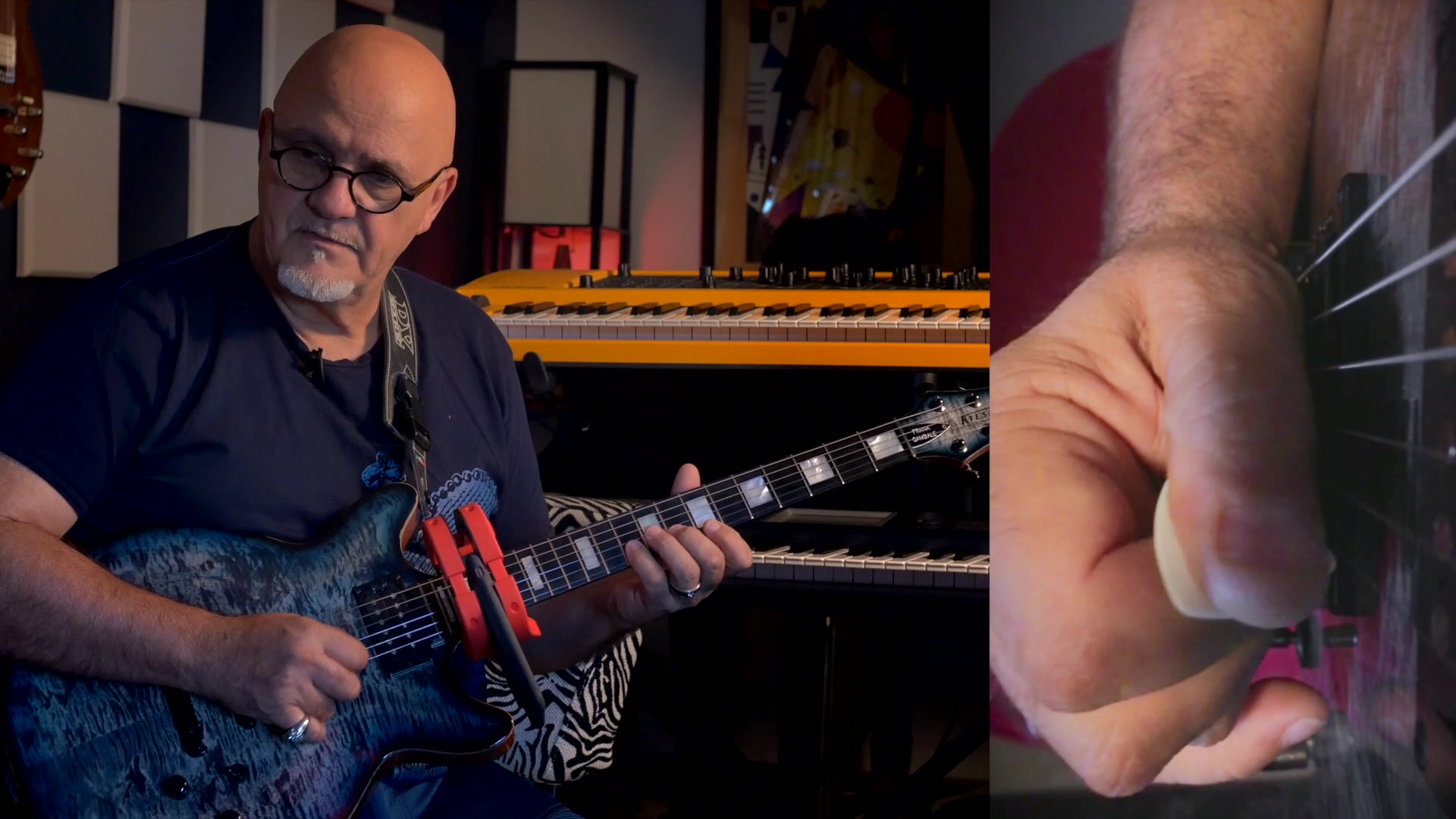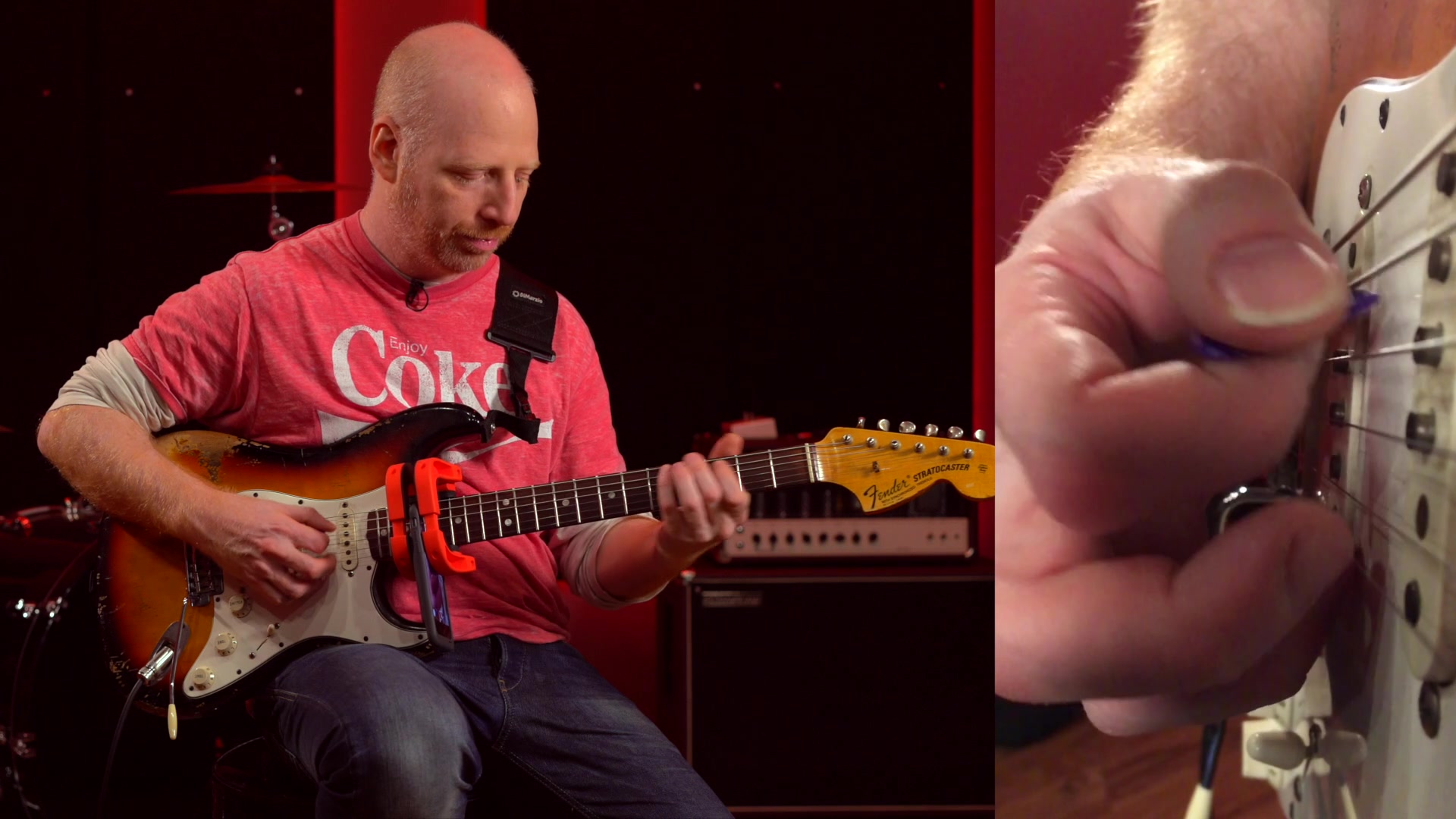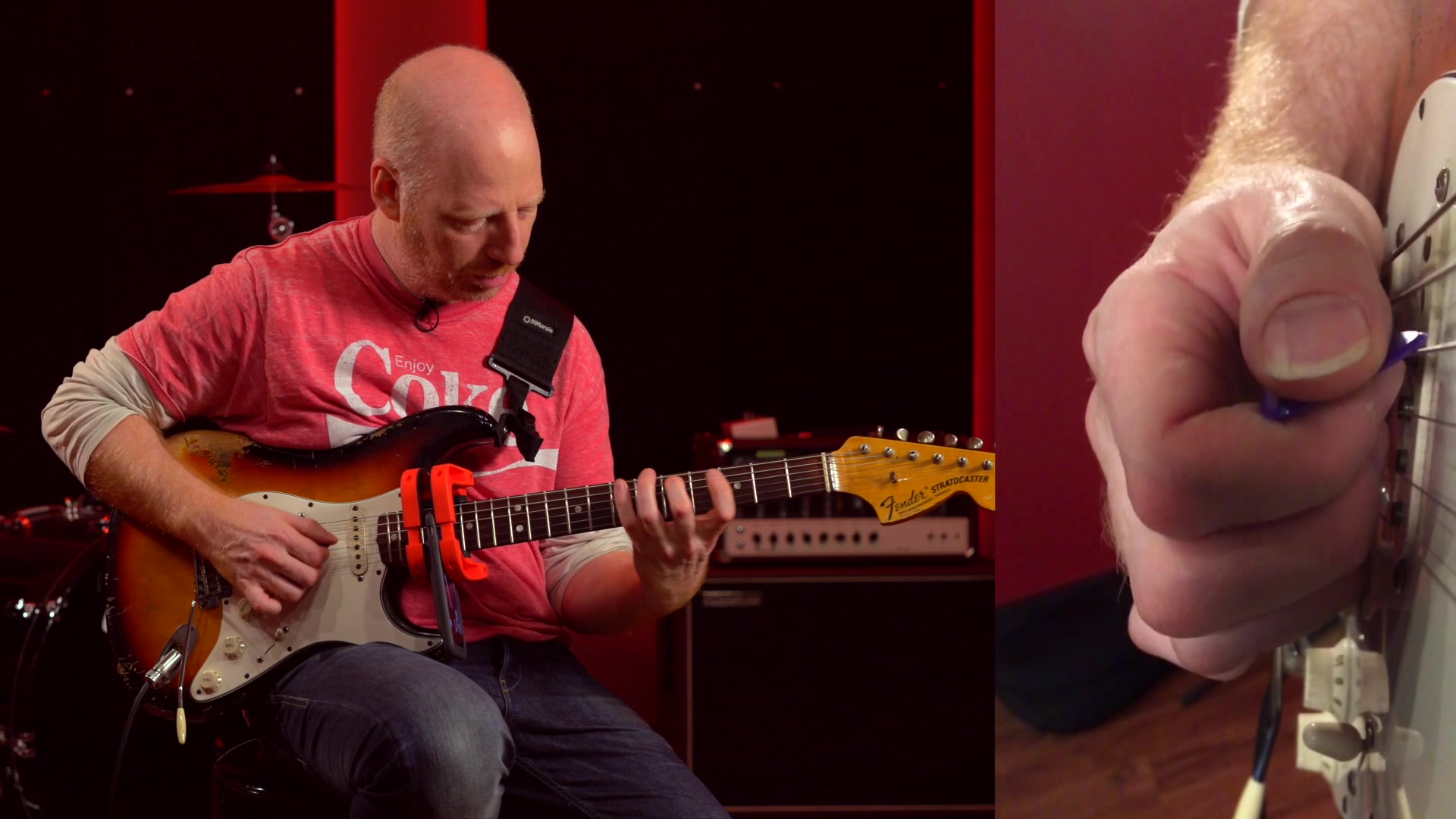Pickslanting And Sweeping
In sweeping, pickslanting is used to enable sliding in the direction of the sweep. By joining forces with alternate picking motions that use the same pickslant, you can unleash the power of economy picking.
Sweeping is a trapped picking motion that moves across multiple strings, playing a note on each one. When you do this with a pickslant, the angle of attack this creates is less than 90 degrees:
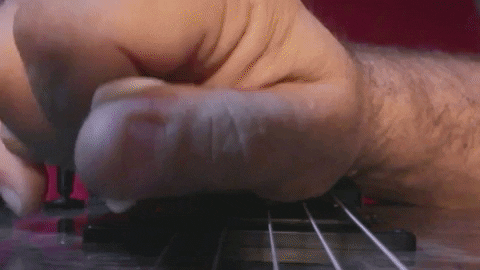
In this example from sweep pioneer Frank Gambale, the upstroke sweep moves parallel with strings from left to right across the screen. The pickslant is UWPS, or upward pickslanting, so it slants to the right on the screen, the same direction as the sweep is moving. The angle between the two isn’t 90 degrees, but somewhat less, about 75 degrees or so.
So this is like the garage spikes problem, just the good half of the problem that promotes more sliding when the angle of attack is less than 90. If you tried to sweep in the other direction using the same pickslant, you’d run into the other part of the garage spikes problem, where the pick would dig under the strings and get stuck:
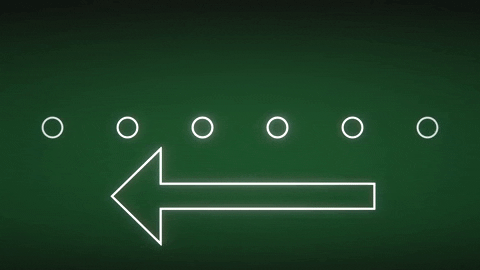
This is happening because the pickslant is incorrect for the direction we’re trying to go. To fix it, we just reverse the pickslant to DWPS:
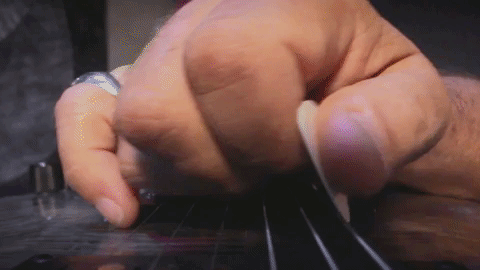
This gives us a sub-90-degree attack in the downstroke direction, and we can now slide smoothly again. Combining UWPS and DWPS to promote smoothness in both directions like Frank does is an approach we sometimes call two-way pickslanting:
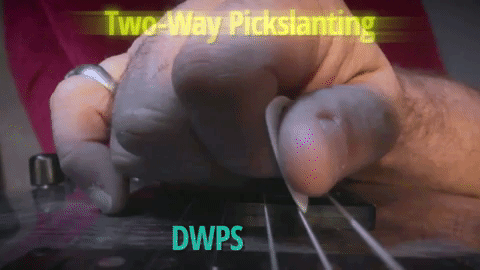
Technically speaking, pickslanting isn’t strictly necessary to achieve smooth sweeping. After all, we learned from alternate picking technique that an attack of 90 degrees works perfectly fine for both picking directions, downstroke and upstroke. However what we’ve noticed by filming great sweepers is that almost everyone uses some amount of directional pickslanting during sweeping, even if it’s slight. As an example, here’s shred pioneer Michael Angelo Batio executing his famously smooth five-string minor sweep arpeggios:
Mike makes a small adjustment to his form to promote two-way pickslanting, achieving DWPS on the downstroke sweep, and UWPS on the upstroke sweep. It’s tempting to think these small attack changes are simply caused by the force of the string pushing back against the pick. However you can see in the still frame of the video clip that Mike is already holding his pick in a DWPS orientation even before starting the phrase.
And if you watch closely, you can see that when Mike gets back to the bass strings to start the pattern over, he shifts the pickslant back to this DWPS orientation before even contacting the string. So these changes, however subtle, are actually deliberately learned joint motions, even if they can sometimes feel automatic to the player after so many years of doing them.
Economy Picking
Even though Frank is known for his sweep innovations, most of his signature lines actually qualify as economy picking, or phrases which combine alternate picking and sweeping together. Frank knows this and has dubbed his particular style of economy picking “Gambale Sweeping” to refer to his use of sweeping in both directions, together with alternate picking.
The way this works is extremely clever. To reveal it, let’s take a look at Frank’s use of upward pickslanting. Upstroke sweeps in Frank’s technique rely on upward pickslanting for smoothness, and so does his DSX alternate picking motion. In fact, these two motions don’t even move in the same direction:
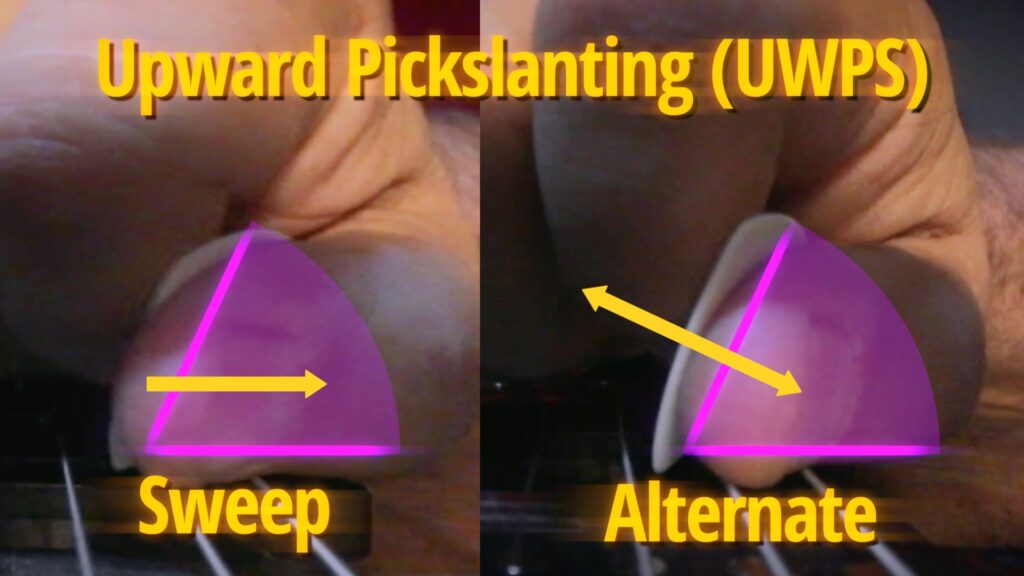
As we can see above, sweeps move parallel to the strings, left to right across the screen, while the DSX alternate picking motion moves along a diagonal, from the upper left to the lower right of the screen. But they can both still use the same pickslant. So whenever Frank uses upward pickslanting, he can access both techniques, right inside the same phrase. This amazing mechanical coincidence allows Frank to combine these two picking motions together in all sorts of ingenious ways:
This expertly crafted phrase is a cascade of overlapping patterns that flows seamlessly across the strings. Every string change is executed either via an upstroke sweep or an escaped downstroke. The two techniques complement each other perfectly. DSX picking motion can only switch strings using a downstroke, and upstroke sweeps can only move to a new string using an upstroke. So by combining the two, we attain the ability to switch strings using either pickstroke.
One Way vs Two-Way Economy
In this approach, the upstroke sweep allows us to economize on pickstrokes, playing two or more notes with the same trapped motion. So this phrase is an example of one-way economy, because it uses sweeping on only one pickstroke, the upstroke. We sometimes call this specific approach upstroke economy or UWPS economy.
The ingredients of upstroke economy are UWPS and DSX. If the abbreviations get a little confusing, just think about the two string changes you’re trying to make. Upward pickslanting gives you upstroke string changes through sweeping, and downstroke escape motion gives you downstroke string changes through alternate picking.
This formula also works in reverse to create another type of one-way economy. We can combine DWPS and downstroke sweeps with USX motion and escaped uptrokes. Here’s economy wizard Oz Noy playing an ascending arpeggio with this approach:
In slow motion it’s easy to see how Oz makes these two string switching techniques work together. He handles downstroke string changes with sweeping, playing two strings with one trapped motion. And upstroke string changes are escaped, rising up into the air to move to the next string unimpeded. This combination of DWPS and USX motion gives us downstroke economy or DWPS economy.
Finally, we can glue these two approaches together into two-way economy. Here’s Oz playing the arpeggio again in both directions:
Even without stepping through this example in slow motion, Oz’s expert use of two-way pickslanting is super clear. The ascending side of the arpeggio is DWPS economy, changing strings with a combination of downstroke sweeps and upstroke escapes. The descending side is the reverse, utilizing UWPS with upstroke sweeps and downstroke escapes. If you look at the pick while he’s doing this, it’s really easy to see the pickslant flip flop with each change in the lick’s direction.
It’s more confusing to write this stuff out than it is to actually do it! In fact, Oz himself explained that he never thinks about the motions he makes, even he as expertly demonstrated different intricate combinations on the fly in our discussion. This is good news. All these moving parts, including the sweeps that slide and the escapes that fly, work together so naturally that you can actually feel your way through even complex phrases like these once you learn how to perform the basic motions.

